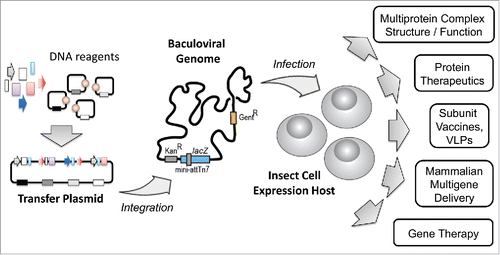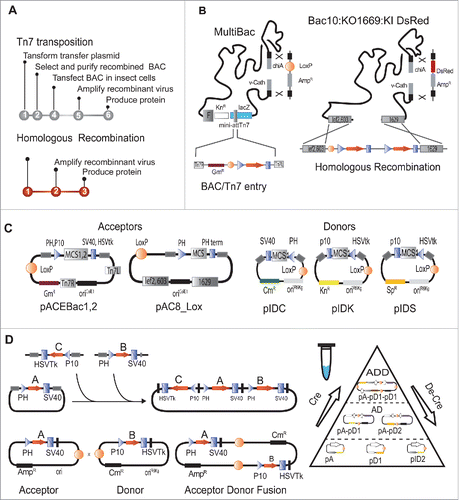Figures & data
Figure 1. Baculovirus Expression Vector System BEVS. The BEVS can be conceptualized on 3 levels. DNA elements comprising genes of interest, promoters, terminators, transcriptional enhancers and others are combined with plasmid backbone modules into (multi)gene expression cassettes on transfer plasmids (left). Transfer plasmids are then integrated into a baculoviral genome by using transposition or recombination methods to yield a composite baculoviral genome containing all heterologous DNA elements (center). Recombinant baculovirus containing the composite genome is then used to infect insect cell cultures to produce materials for a multitude of down-stream applications (right). All three levels, transfer plasmid assembly, the baculoviral genome and the expression host cell, can be engineered by exploiting powerful synthetic biology tools, for optimizing and maximizing system performance.

Figure 2. Baculovirus multigene expression tools. (A) Flowcharts for production of recombinant viruses and protein expression protein production using either Tn7-mediated transposition (top) or homologous recombination (bottom) are shown. (B) Construction of recombinant baculovirus genomes are shown in a schamtic representation. Transposition of an expression cassette embedded between the Tn7L and Tn7R DNA sequence into the Tn7 attachment site of the baculoviral genome is illustrated on the left (from Ref. 8). Homologous recombination combining a linearized baculoviral DNA genome and a transfer plasmid for inserting the gene(s) of interest is shown on the right (from Ref. 13). Most currently used viral genomes contain deletions of the genes encoding for chiA and V-cath, a chitinase and protease, respectively, shown to be detrimental for protein production and stability. This locus can be used to insert foreign genes including fluorescent makers such as YFP or the DsRed protein to monitor virus performance and protein production. A LoxP site-specific recombination site, inserted at this position, allows to generate composite viral genomes by in vivo Cre-LoxP fusion in E. coli with a customized transfer plasmids containing a conditional replication origin.Citation9 (C) Multigene assembly DNA tools used in tandem recombineering (TR) are shown. So-called Acceptor and Donor plasmids contain multiple cloning sites (MCS) to insert genes of interest by conventional or samless cloning methods of choice. Genes are placed typically under the control of late baculoviral promoters (PH or p10) and eukaryotic polyadenylation signals (PH ter, SV40 or HSVtk). Acceptors and Donors possess multiplications modules (gray rectangles) located on both sides of the expression cassette as well a loxP site (circle filled in orange). (D) For multi-gene construct generation using multiplication modules, individual expression cassettes are excised by digestion with a pair of endonucleases and inserted via compatible restriction sites into the multiplication module of a progenitor plasmid. Following ligation, the restriction sites used for integration are eliminated and multiplication can be repeated iteratively using the intact multiplication module in the inserted cassette.Citation9 Plasmids thus charged with several genes of interest can be fused by Cre mediated recombination via the LoxP sites. Acceptors have a regular origin of replication (ori ColE1), whereas donors have a conditional origin derived from R6Kγ phage (ori R6Kγ), facilitating multigene assembly.Citation21,30,39

